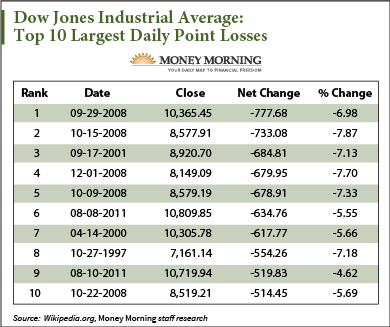Updated June 24, 2016: The Dow Jones Industrial Average plunged more than 510 points to 17,500.74 in opening trade today after Brexit sent international markets sharply lower. [Editor's Note: George Soros has projected a Brexit will lead to a currency crash. Click here for a better primer of what’s to come.]
As panic-inducing as this plummet may seem, today's slip isn't even half as big as the worst daily point drops in Dow history.
Here are the 10 largest one-day plunges ever in the Dow's closing value. Note: These are not the largest changes during the trading day (intraday).

What Triggered the Top 10 Single-Day Stock Market Crashes
The biggest ever single-day crash on Sept. 29, 2008, came after the U.S. House of Representatives rejected the government's $700 billion bank bailout plan. This Dow drop obliterated $1.2 trillion in market value.
News that Wachovia (which was acquired by Wells Fargo in 2008) had to sell its banking assets to Citigroup (NYSE: C) the same day didn't help, nor did the collapse of a number of European banks.
Amidst the subprime crisis, the Dow's second biggest single-day drop happened six days later on Oct. 15, 2008.
This time, recession talk fueled the 7.9% decline. A weak sales report, bleak forecasts from the U.S. Federal Reserve, and sober comments from Fed Chairman Ben Bernanke all contributed to the day's plummet. (Which was still far off from the largest-ever percentage loss - 22.6% on "Black Monday," Oct. 19, 1987.)
Subprime financial crisis-related events that triggered the top two largest single-day Dow drops also account for the fourth, fifth, and tenth largest. The Dow hit an (at the time) all-time high on Oct. 9, 2007, closing at 14,164.43; by March 5, 2009 - a little under 18 months later - it had fallen more than 50% to 6,594.44.
The third-largest single day crash occurred on Sept. 17, 2001, seven years before the subprime crisis would beat the 684-point drop. Trading resumed for the first time following the Sept. 11 terrorist attacks - the longest trading pause since the Great Depression. The airline industry suffered the most; weakness in airline stocks would send the Dow Jones Transportation Average down 15% this day.
Fast forward 10 years to Aug. 8, 2011. Wall Street suffered its worst drop since 2008's subprime crisis on news that the United States might lose its AAA credit rating. U.S. stocks declined 15% over the two weeks leading up to the Aug. 8 fall.
"Investors are having one reaction to the downgrade: sell first and ask questions later," ING Investment Management's head of asset allocation Paul Zemsky told CNN.
The European debt crisis was also underway. This would be the sixth-largest daily point loss in Dow history. On Aug. 10, 2011 - two days later - the Dow would suffer its ninth-largest daily point loss under the same pressures.
The seventh-largest daily point crash was caused by Fed fear. On April 14, 2000, the government reported prices at the consumer level showed surprising strength the month before. As a result, investors feared the Fed would aggressively raise interest rates.
This rings eerily familiar to present-day market volatility caused by the Fed's decision to start scaling back its quantitative easing (QE) program.
On Oct. 27, 1997, the Dow plummeted 544 points for the eight-largest daily point crash in Dow history. All the major exchanges posted huge losses, and collectively U.S. stocks lost $663 billion in market capitalization.
The Hong Kong Hang Seng Index was the culprit - it dropped 6% in trading, sparking a mini-crash on the Dow. Interestingly, the Dow closed 30 minutes early that day because it'd reached "circuit breaker levels," according to the U.S. Securities and Exchange Commission.
Volatility has certainly defined the markets in the early weeks of 2014. But rather than locking in losses on the sidelines, here's how to take advantage of the profits that the boom/bust crowd is leaving behind...
Join the conversation on Twitter on market #volatility in 2014, and be sure to follow @MoneyMorning.
Related Articles:


